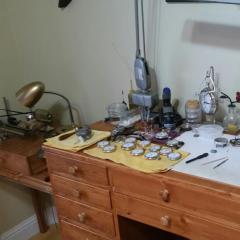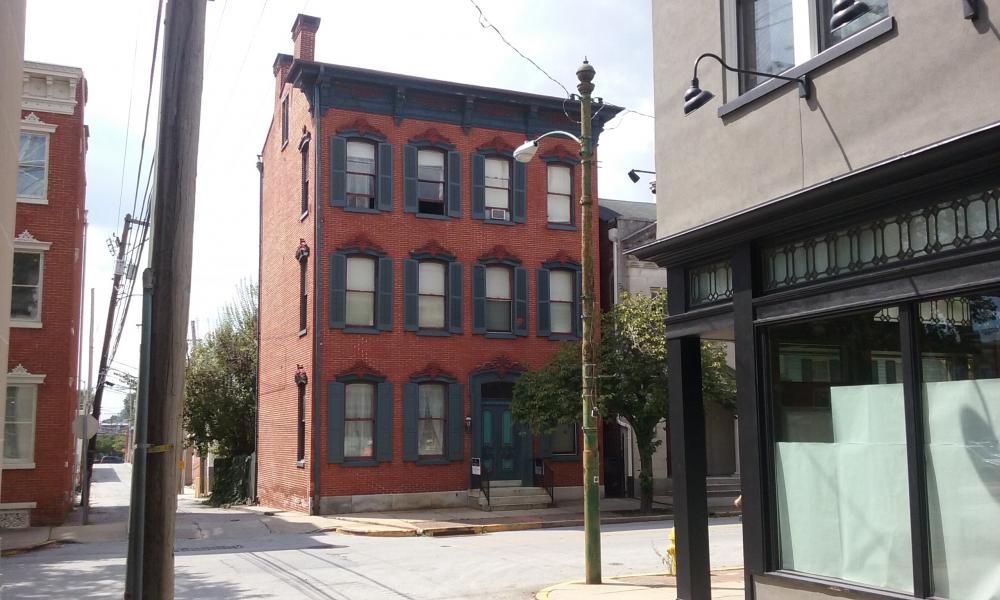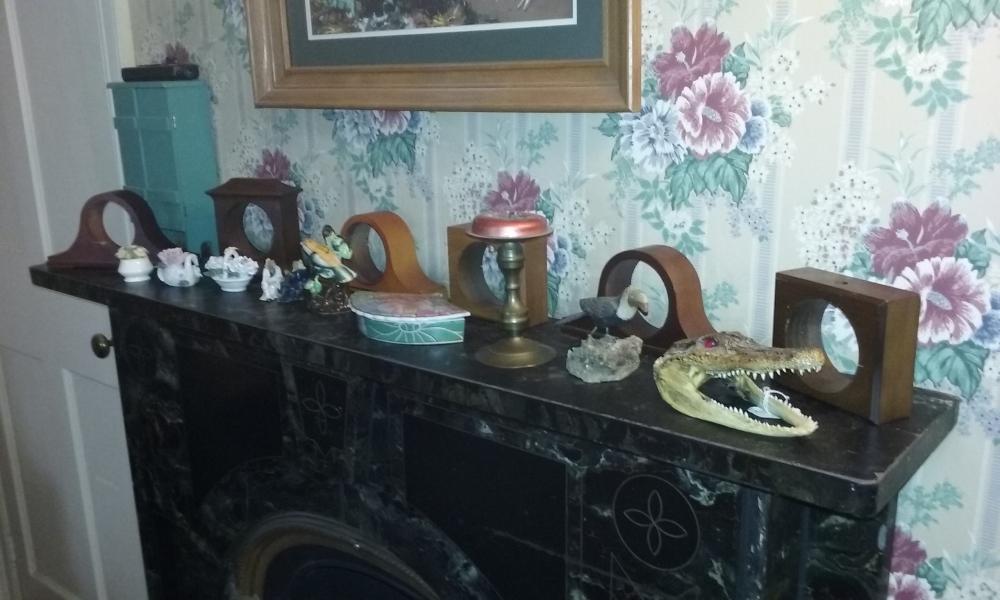Leaderboard
Popular Content
Showing content with the highest reputation on 02/27/18 in all areas
-
Well, the day is finally about to arrive (September 16)! After two years of living a split existence between my home on weekends in Berkeley Springs and weekdays in York, Pennsylvania, I'm finally done. I lived in an old rooming house in downtown York (see picture below) and my small school was a few blocks away. Two years is enough time to develop a habit of living and, waking this morning, I still felt like I had to make the 100+ mile drive to York this morning. But I didn't and that's a good and a bad thing. Good because I can now call my home my home again. Bad because a phase of my life has ended, probably for good. I'm sentimental about such things and this latest venture has often brought me nostalgic feelings about starting graduate school at New York University in 1980. That period ended in 1985 when I packed up and went to a post-doctoral fellowship at Northwestern University, both now over 30 years ago. So what can I say about watchmaking school? When I first started I wrote down on this website some of my initial impressions and followed it with an occasional update. For those who have the time and the resources I would say, go for it! It accelerates one's progress because you don't have to re-invent the wheel--something to be avoided unless you have a real affinity for wheels! I don't. For those who, like me were complete newbees, knowing nothing about the watch and clockmaking communities, it will allow you to quickly set up a network of fellow craftsmen. In my case going to York was very much like going to the historical heart of American watchmaking. Relatively speaking, there are a lot of watchmakers in central Pennsylvania; probably because nearby Lancaster was the home of the Hamilton Watch Company. It still is the location of the RGM Watch Company whose watches I greatly admire. Because of school I am now a member of the NAWCC, the Central Pennsylvania Watchmakers & Clockmakers Guild and the Horological Society of New York. Also it provided me with a steep ramp-up on acquiring tools--which our craft employs a greater complement than almost any other. I probably would never have seriously considered obtaining a watchmaker's lather or, if I had, not known how to get one that was both useful and reasonably priced. Sure you can get modern one's but they're pretty expensive and, frankly, appear to lack to quality of the older "vintage" lathes. But you have to be careful as there's a lot of old stuff that's been sorely abused and, unless you have a machinist background and recondition them yourself, not worth purchasing. Also what do you get: 6mm, 8mm, 10mm, or does it matter? (Actually, in America 8mm was the most popular and has the most available accessories.) Another advantage to me was that I was forced to work on pieces. Alone, my lack of self-discipline and my harsh internal critic, operant while working alone, pre-school, made it difficult to accept new challenges and complete work. I won't say I have this completely under wraps but I have now worked on a fairly broad range of pieces and have more confidence now. And it has cured me of one disease that I've heard some watchmakers say they had to be cured of: the feeling that you have to save every watch! Many I let go but am careful to inventory as parts watches. Also my fear of breakage is diminished; partly because I feel more confident that I can recover from a blunder and partly because I see my fellow students blunder and realize screwing up is part of the learn process and continues into common experience even for the experienced. (Which is not to say that I don't continue to work towards lowering my blunder rate!) Many will want to know whether or not I am a real, "stand-up", watchmaker like some members of this website? Probably not, though I can see real progress. It's a cliché that schooling, in any discipline, only takes you so far. The rest depends on time served and degree of dedication. As a former teacher, let us not get too hung up on a word I deliberately omitted, talent! Sure there are individuals who have it but my experience is that the bulk of progress is made by people of ordinary ability applying themselves conscientiously. Getting in there with our screwdrivers and tweezers is where, for the individual, our craft starts to take form. My only regret is that, at 66 years old, I won't have enough time to dedicate, say, 40 years to strive for a truly high level of achievement. This is where youth beats old age. Nothing can be done about it, though, except to provide a cautionary tale to those who are still young. Like most youth's I figured real self-examination, as to who I really was and what I would really like to do, fostered upon me by old dotards who weren't as smart as I was. Youth thinks the world is its oyster. Would that they could know otherwise. Sometimes, infrequently, individual youths do "get it" and listen to their elders. So be it but, whether they heed or not, at least those reading this can't say they never heard it from me. The attached pictures are two view of where I lived in York. The house is a nice example of antebellum architecture and is on the local historical registry. The very top floor was the servant's (some would say slave's) quarters. I had a very nice room with a beautiful black marble fireplace which I show decorated with some silly gewgaws I obtained from a local second-hand store. It's all been packed up and taken home, never to be so arranged again (some might say, amen to that!). I'll miss it and my housemates whom I hope to see from time to time. Finally I have a job interview in Philadelphia's diamond district later this month. In America there are jobs for watchmakers going unfilled. If they make the right offer then maybe my wife and I will, once again, pull up stakes and start a new chapter in our lives, in a totally unforeseen area to live. Who would have guessed Philly after living in NYC, Los Angeles, Chicago, Washington D.C. Life is full so unlikely tributaries. But we'll see.1 point
-
Just finished working on this 1894 Elgin 6S, Grade 117, 7 jewel watch, and it seems to be running ok. Hope you enjoy the pics and my little newbie adventure [emoji4] Got the whole watch on eBay, minus crystal and not running well. The gold filled Keystone "cyclone" case is kind of worn down but still looks ok to me. After cleaning, the amplitude was poor, like 180° poor. I pulled the mainspring and it was about as set as they come. A NOS replacement went in. And the amplitude was still terrible! Then the impulse jewel fell out. Until I get my warmer tool, I swapped a balance from a compatible watch just to see if it would run worth a darn. The guard pin needed adjusting and it took me forever to get the beat error down to a crummy 2ms. And still poor amplitude. I remembered seeing divots on the cap jewels so I swapped those. And despite the fairly loose pivot holes, she finally started running right, plenty of amplitude. Whew. Now, it does have a massively bad rate discrepancy between pendant left vs. right. I will have to address that at some point. I recased it (the two had been separated for almost a year now) after finding the stem bits. Cleaned up a couple hands and re-blued them and good to go. Now I just need to find a crystal. Sent from my Pixel 2 XL using Tapatalk1 point
-
1 point
-
I debated whether to post this, it’s verbose and sounds like a lecture. But I see the subject wrestled with all the time and thought a summary from someone who has done lots of it might help you - and the next guy. Here’s imo pretty much all you need to know to get some successful results from DIY heat treating: 1) Drill rod IS tool steel IS Silver steel. The name silver steel is the common name in the UK, drill rod in North America. Also called carbon tool steel. 2) you HAVE to know what tool steel the drill rod is: O1 (oil hardening) or W1 (water hardening). Don't buy drill rod without knowing what it is. Another common tool steel is A2 (air hardening). It’s more expensive so less likely to what he drill rod is at the local outlet 3) Why do you have to know? The quench is different - oil for O1, water for W1, air for A2 4) Why the different quenches? Different fluids (Water, air, oil, ice cold brine) have different quench speeds suitable for different tool steel alloys 5) What happens if I quench O1 in water, and vice versa? Water is too fast a quench for O1, you risk cracking it. Oil is too slow for W1, it won't harden as much as it could/should. 6) Which tools steel is best? W1 is the cheapest. Most imo prefer O1, it machines well and is less likely to distort or crack in the quench than W1 7) What oil to use? Doesn't much matter. I use a mineral oil I keep after draining a machine tool’s gearbox. For the size of parts watchmakers deal with, just get a quart of hydraulic oil from the hardware/auto store (Canadian Tire for us canucks). Hydraulic oil is just very pure mineral oil without all detergent and additives in motor oil (which you could also use, used or new). Use a tin can, not a glass jar or plastic container. Ideally the oil should be warmed on a hotplate (slower quench for O1), but I confess I don’t usually bother without ill results (cracking) 8) is the quench dangerous? no, for the size of stuff we’re doing. It takes a lot of heat to ignite oil. You'll get a small plume of smoke that smells and that's about it. There are special quench oils with a high flash point available; they make less smoke; I’ve never bothered 9) Where to get O1? Any industrial supply place. In Canada, metal supermarkets, Fastenal, Granger, Brafasco, KBC - heck even some hardware stores. Catalogue houses, KBC, McMaster Carr, MSC and so on. It’s so common it should be like picking up milk on the way home lol. I would avoid ebay and offshore mail order, while metallurgy and controls have only gotten better, the same hasn't necessarily happened to QC in the developing world. I think the last time I bought small dia O1, its was $3 or $4 for a 3' piece of 1/8" O1 from KBC. imo its not worth going to a less than mainstream source....the mainstream vendors mostly sell to industry and that's your QC, business and toolmakers won't put up with crappy tool steel. 10) What is heat treatment? If the steel has enough carbon (is a tool steel), you can change its state by heat treating. This is usually done to harden the material. Three words to know: Hardened, Annealed and Tempered 11) Hardened. The steel has been brought up to its critical temp (1500F or bright red in sunlight) held for a bit then quenched. When above the critical temp, the molecules arrange themselves in a structure (austenite) that gets "locked in" when its quenched. After a proper quench the steel is as hard as it can get, and also brittle. 12) Tempering. After hardening, the steel temp is raised again, slightly, to let it down or remove some of the brittleness at the expense of hardness. How much its let down is (mostly) a function of temp and it so happens these temps correspond well to some colours. light straw through blue etc. You temper to a higher temp, say blue, around 600F, for something like a screwdriver - you want it somewhat hard, but not brittle. A cutting tool you'd temper less. When tempering you can quench to stop the tempering or heat flowing, but it’s not necessary for the tempering to work Polish a bit of the hardened steel so you can see the tempering colours, heat slowly, they change rapidly 13) Annealing or annealed steel. Steel in its soft state, unhardened. Except for special examples like watchmakers blued steel (which will be O1 or W1) tool steel is sold annealed so it’s ready to be machined into whatever 14) how is annealing done? Kind of the opposite a rapid cool (quench). Heat to critical temp and then slowly cool. Slowly as in overnight (a steel box full of ashes works well – use extra thermal mass if the part is small). With a proper anneal the stress in the metal will be removed and it will be soft. You'll hear of guys talking about annealing in much short time frame; what’s really happening is it’s a partial anneal - they've softened it enough for what they need. Residual stress may remain which could lead to cracking on subsequent quenches (if necessary) 15) Casehardening. By soaking a non tool steel in an environment (a bath or packed with carbon around it in a steel box) where it can absorb carbon for a period of time, you can get it such that the out layer has enough carbon to then be heat treatable. It’s then quenched. It is not usually (ever?) tempered. The idea is it’s an advantage having a dead hard skin and ductile core. The skin depth might be 1 -2 thou using casehardening compound, 5-10 thou with long pack hardening and 50 thou with an overnight soak at a commercial heat treaters. It’s good for wear parts, not so good for most tools 16) HSS – high speed steel. High speed steel is another group of tool steels we see, drills, lathe tools etc. Its great advantage is it holds its hardness at high temps, unlike say O1 that starts to anneal at a few hundred degrees. This matters as where one molecule meets another when cutting, temps can go very high. HSS cannot be heat treated by the likes of us, there is a very narrow band of tolerance on the temperatures and cycles required1 point
-
Grab some silver steel rod. Or anneal some blue steel. You want a carbon content of around 1%. It’s cheap and handy to have knocking about for making tool parts. Oddly, I can’t see any for sale on the Canadian ebay, apart from stuff from the Far East. I’d be slightly hesitant to buy stuff from there to be honest. Allegedly, a lot of the Sheffield steel rod which we buy in the UK is often old stock, and sometimes made by Stubs. I can post you some if you get stuck finding any.1 point
-
Oh, that's right. You put up images and a write-up of a staff you were turning a while back. Good on ya.1 point
-
1 point
-
I broached the hole a bit and got the spring in. Sent from my iPhone using Tapatalk Pro1 point
-
If it came out it has to go back in, I wouldn't try narrowing the spring or messing with the stud....spring goes on the inside of the stud hole closest to the balance staff, brass pin goes on the outside of the spring1 point
-
The Timex is a good watch to start with if you want to understand the fundamentals of how a mechanical watch works but I will caution that putting that watch movement back together will be a chore. I consider Timex watches the "Everest" of watch repair; I haven't yet successfully repaired one.1 point








